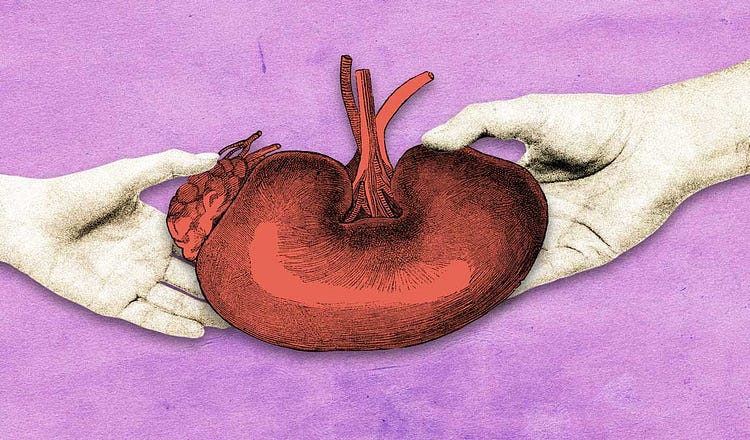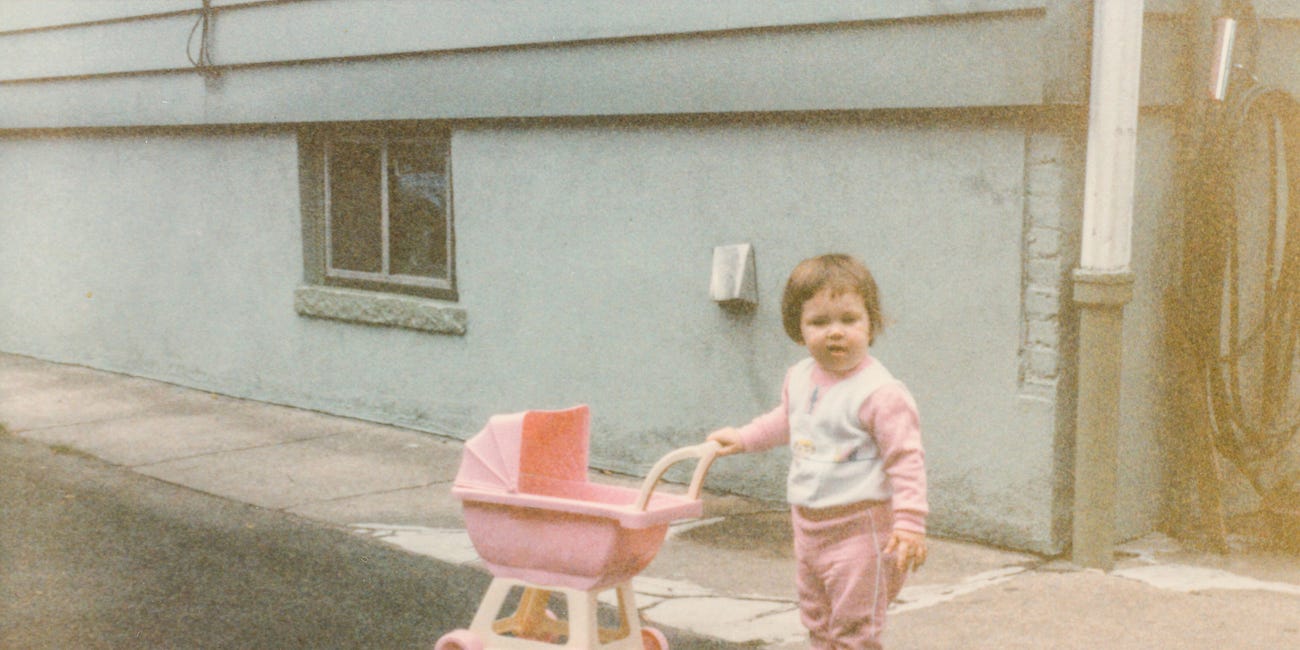
The Free Press

On a steamy day in August 2004, I went to the doctor for a routine checkup. I was feeling completely fine, but routine blood work revealed that my kidneys were in bad shape. Further testing showed them functioning at 16 percent of normal capacity. The cause couldn’t be determined, but evidently my kidneys had been deteriorating for a long time, probably decades.
Now, suddenly, at the age of 48, I needed a donor. The alternative was dialysis, tethering myself to a machine to clear the toxins from my blood three times a week for an indefinite number of years. It would be grueling, and it wouldn’t keep me alive nearly as long as a transplant could.
At first, I was sober, focused on the crucial task ahead of me. But as months rolled by without securing a donor, the panic started to set in.
There were no family members able to help. Five friends considered donating, but ultimately got cold feet. In two cases, their husbands threatened divorce, lest something go awry during surgery or a family member need that kidney in the future. Meantime, I started to notice symptoms: fatigue, shortness of breath, swollen ankles.
By November 2005, right as I was losing hope for a new kidney and preparing to begin dialysis, word of my condition reached someone I barely knew. Virginia Postrel, a loose acquaintance at the time, found out about my situation through our close mutual friend at a conference.
I received a simple email from her: “If I’m compatible, I’ll be a donor. Best, Virginia.”
Mercifully, Virginia’s blood type was indeed compatible with mine. A few months later, I received my first transplant.
A healthy kidney from a living donor usually lasts 15 to 20 years. But after 10 years of living with Virginia’s kidney inside of me, I began to feel the familiar symptoms that indicate poor renal function. A blood test confirmed that Virginia’s kidney had begun to wear out. Once again, I needed a transplant.
That’s when my friend, Kim Hendrickson, who had witnessed me struggle to find a kidney donor the first time, told me: “I’ve been keeping mine warm in case you’d ever need it.”
I did need it. So in July 2016, I received my second transplant.
I am obscenely lucky. Every year, thousands of people die because they lack a family member or friend willing—and healthy enough—to donate a kidney. To be precise: 11 Americans on the transplant waitlist die every day.
This is, in large part, thanks to the 1984 National Organ Transplant Act (NOTA), which has made it illegal to give or receive anything of material value for an organ. If people were able to pay donors for a lifesaving transplant, we might instantly eradicate kidney disease deaths. And the more than 100,000 Americans who have died needlessly since NOTA was signed into law might still be alive today.
NOTA reflects an understandable aversion to a traditional free-market system, in which wealthy recipients could buy kidneys while others could not, and where immediate cash payments could be made to financially desperate and uninformed donors.
But now, legislation is on the table that would save these patients’ lives while eliminating those concerns. On April 7, the House introduced the End Kidney Deaths Act, bipartisan legislation that would dramatically increase kidney transplants by providing a $50,000 refundable tax credit, payable over five years, to any living donor who gives a kidney to the next person on the waiting list.
Under the EKDA, buying organs would remain illegal—but the federal government would reward donors for saving people’s lives. What’s more, disbursing the tax credit over an extended period—rather than offering an immediate lump sum—along with standard informed-consent requirements, would ensure that desperate people do not rush to donate to score an immediate financial payoff and later regret it.
For decades, advocates have waged public education campaigns. They have offered paid job leave and reimbursements for childcare, travel, and other donor-related costs. From 2007 to 2024, the National Living Donor Assistance Center’s reimbursement program—which pays up to $6,000 to living donors—facilitated over 10,000 transplants. Every organ is a godsend, but still a drop in the bucket. And so, the enormous chasm between supply and demand remains.
Altruism is a magnificent virtue. I was twice its beneficiary. But we can’t rely on the small number of earthbound saints willing to save a life. Not with almost 91,000 people awaiting a kidney. We need to better incentivize potential donors.
Critics object that rewarding donors “commodifies the body.” But we already commodify the body every time there is a transplant: The doctors get paid to manipulate the body, and the hospital charges for the kidney’s removal. Why should we object to remunerating the person who gives the precious organ in question and assumes all the risk? (Kidney donation is quite safe, but it still requires surgery, a weeks-long recovery period, time off work, etc.)
At the heart of the “commodification” claim is the concern that donors will not be treated with dignity. But dignity is affirmed when we respect the capacity of individuals to make decisions in their own best interest, protect their health, reward them amply, and express gratitude for their sacrifice. The same conditions should satisfy those who worry that people are giving a kidney because they need the money. Well, of course they value the money. That’s the point of an incentive.
Besides, humanitarian and financial motives intertwine all the time. Are we any less grateful to the firefighters who rescue us because they are salaried; are they any less heroic than their volunteer counterparts? During the 2008–2009 recession, I received letters from people saying, “I wish I could sell my kidney, and get out of foreclosure,” or “keep my business,” or “pay some bills.” Every one of those people said that they would love to be saving someone’s life while making their own less precarious.
Compensating donors is not crossing a practical or conceptual Rubicon. We already pay donors for products of the body: sperm, ova, blood plasma, bone marrow, and breast milk. We are the world’s biggest exporter of blood plasma to countries who do not pay their donors (and, therefore, do not have enough). The market in corneas is robust and growing.
Fears that the poor will hastily become organ donors out of desperation can readily be addressed. Transplants do not happen overnight. There is a monthslong medical clearance and education process, and the prospective donor can back out at any time. As for being poor, why doubt the capacity of a willing and informed low-income person to make the right decision for themself?
Indeed, it is low-income individuals who stand to benefit the most, as they are disproportionately represented among those who perish while on the transplant waitlist.
In addition to saving lives, the tax break from the End Kidney Deaths Act would pay for itself. On average, Medicare spends $82,000 a year for every person on dialysis. In total, the U.S. government spends nearly 1 percent of its entire budget on dialysis costs. As more patients receive kidney transplants, the revenue loss from the tax credit would be more than offset by reduced dialysis costs.
Now is the ideal time to reform transplant policy. On April 10, Congress adopted a major budget bill to cut federal taxes and spending. It has until mid-May to finish the reconciliation process and should seize the opportunity to save lives and money by including the End Kidney Death Act in the bill.
The next few weeks of negotiation in Congress will be critical to enact a transplant reform that finally recognizes the truth: There is not enough generosity, precious as it is, to save thousands in need of a kidney. Only rewarding people financially for saving lives will encourage more to do the same.
Sally Satel is a psychiatrist and a senior fellow at the American Enterprise Institute. Follow her on X @slsatel.
Read Naomi Schaefer Riley’s report on Child Protective Services:
Last fall, we reported on the epidemic of overreaching government agencies falsely accusing good parents of neglecting their children. We applaud the work of Lenore Skenazy at Let Grow, the organization that encourages adults to allow elementary school kids to run simple errands or play in a park unsupervised without their parents fearing arrest.




